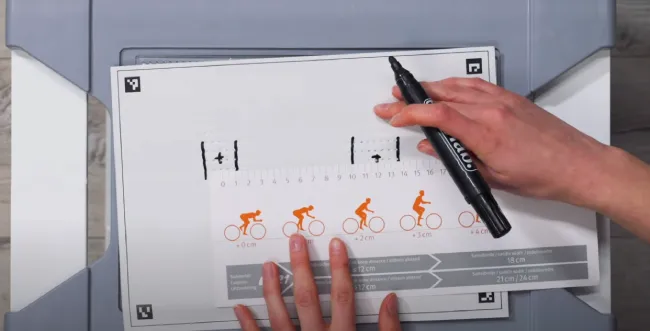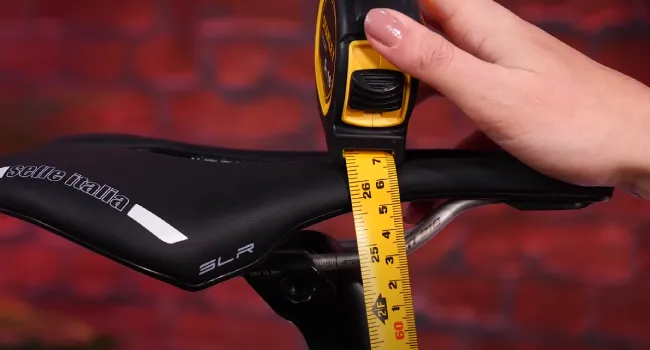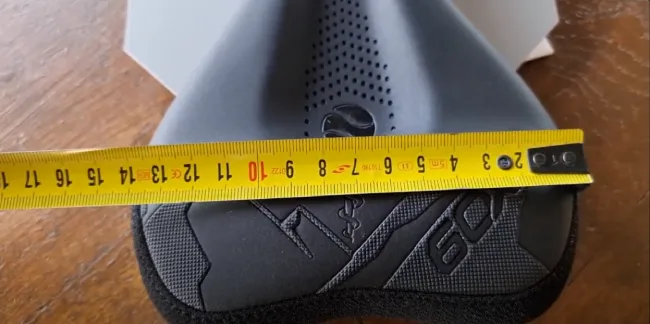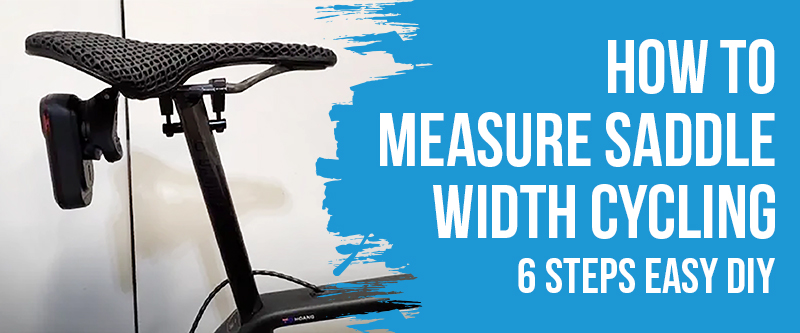A saddle that’s too narrow or too wide could cause discomfort in the pelvis, leading to numbness, tingling, or even erectile dysfunction in men. For women, an ill-fitting saddle can cause chafing, pain, and even infection in the genital area.
Sit with your feet tilted up long enough to leave a good impression. Stand and find the two deepest indentions your sit bones left behind and mark them both with a point. Measure from one end to the other in millimeters with your measuring tape. Add 20-25mm to determine your saddle size.
In this blog post, we’ll explore measuring your saddle width, the benefits of measuring your saddle width, and factors to consider when choosing your saddle width.
How To Measure Saddle Width Cycling: 6 Step-by-Step Guide

Measuring the width of your bike saddle is critical to ensure your comfort and proper bike fitting. A wrong saddle width can cause discomfort, pain, and injuries while cycling. Measuring your sit bones is essential for finding the right bicycle saddle fit. Here are a few methods you can use at home:
Measure sit Bone width
The sit bones, or ischial tuberosities, are at the base of your pelvis and support your weight when sitting. If you want to measure the width of your sit bone, follow these steps:
- Sit on a piece of corrugated cardboard or a special saddle-width measuring tool.
- Lean forward to mimic your riding position, feet shoulder-width apart, knees at a 90-degree angle.
- Roll your pelvis forward and back to ensure you’re sitting squarely on your sit bones.
- Lift your legs briefly to leave an indentation on the cardboard or measuring tool.
- You can measure the indents using a tape measure or a ruler. This is your sit bone width.
Choose the right saddle
Based on your sit bone width plus the added measurement, select a saddle with the width. Finding a saddle that fits your body comfortably and suits your riding style and preferences is essential. Here are some tips to remember:
- Look for a saddle shape that matches your pelvic anatomy and riding position. Women have wider sit bones and may prefer a saddle for female anatomy.
- Choose a high-quality saddle with sufficient padding and ventilation to prevent friction, heat, and moisture buildup.
- Consider the length, width, and cutout shape of the saddle, as well as the rail material and shape and the weight and durability of the saddle.
- Test-ride the saddle before purchasing it, either by borrowing it from a friend or using a demo program offered by a bicycle shop. Make sure you spend enough time on the saddle to assess its comfort and
suitability for your needs.
Add 20-30 mm
Men typically have sit bones that are 120mm wide and women have them 130-135mm wide, based on my measurements. Sit bone width might be expected to vary as much as human height, but less than 110mm and greater than 140mm are quite unusual.
Prepare your Bike
To measure your saddle width, you’ll need to remove your current saddle from your bike’s seat post. To do this, loosen the screws on the saddle clamp using an appropriate wrench and carefully lift the saddle off the post.
Tools for Measuring Saddle Width
As previously mentioned, corrugated cardboard is an economical method to measure saddle width. There are specialized tools available that offer better accuracy and efficiency in finding the correct saddle width. Below are some highly recommended tools for measuring saddle width:
- Saddle width measuring tool: Specialized tools, like the Bontrager Saddle Sizer, accurately measure your sit bone width and take out the guesswork of figuring out the correct saddle width.
- Bike shop assistance: Many bike shops offer saddle fitting services where trained staff can measure your sit bones and recommend the best saddle based on your body shape and riding style.
Tips for Accurate Measurement

You should keep these things in mind when measuring your saddle width for the most accurate results:
- Measure multiple times: While it may seem redundant, measuring your saddle width multiple times is essential to ensure accuracy. Taking several measurements will help you get the most precise result, and it will also help you develop a better understanding of your saddle width.
- Wear cycling shorts: Wearing cycling shorts during your measurement process can make all the difference. That’s because cycling shorts have padding that helps keep your sit bones in place. As a result, you can more easily feel where your sit bones are and measure the saddle width from there.
- Consider your riding style: Your saddle choice will depend on your style. For instance, if you are a road cyclist, it’s recommended that you use a narrow saddle. You may want a wider saddle for better stability if you’re a mountain biker.
- Test ride the saddle: you must test ride the saddle before you make a final decision. This will allow you to experience how the saddle feels on your bike and how comfortable it is.
5 Factors to Consider When Choosing Saddle Width
For cycling, choosing the correct saddle width can affect your comfort level. Using an improper saddle width can cause discomfort and even lead to painful and long-lasting injuries. To prevent this, it is important to consider the following factors when selecting the saddle width for your cycling needs:
Determine Your Pelvic Bone Width
The pelvic bone width plays a significant role in choosing the correct saddle width. To measure your pelvic bone width, follow these steps:
- Sit on a flat surface like a bench or step.
- Put some cardboard or foil on the bench.
- Maintain a straight spine and flat feet while sitting.
- Lean forward slightly and wiggle your buttocks off the bench. Your sitting bones should leave an impression on the cardboard or foil.
- Measure the distance between the centers of the two impressions using a ruler. This dimension will be your pelvic bone width.
Consider Your Riding Style
Your riding style will also influence the saddle width you need. Here are some examples:
- Casual riders prefer wider saddles as they provide more support and comfort.
- Road racers prefer narrower saddles, allowing greater leg movement and pedaling efficiency.
- Mountain bikers often choose saddles wider in the back and narrower in the front to allow more maneuverability and control.
Measure the Distance Between Sit Bones
Your sit bones are the bony protrusions you feel when sitting on a hard surface. Measuring your sit bones’ distance is critical in determining your required saddle width. Many bike shops have “sit bone measuring devices” to help you accurately determine your sit bone width. If one is unavailable, you can measure it at home:
- Sit on a hard, level surface, such as a bench or a chair.
- Place a piece of cardboard or a soft foam mat on the chair.
- Sit with your spine upright and your feet flat on the ground.
- Leaning forward slightly, lift your buttocks bones off the cardboard or foam mat.
- Your sit bones left two impressions. Measure the distance between them.
Saddle Shape and Design
The shape and design of the saddle can significantly affect how comfortable it is. A good saddle should:
- Have sufficient padding but not be too soft that it causes chafing or rubbing.
- Be shaped to support your sit bones.
- Have cutouts or curves that reduce pressure on sensitive areas.
- Be made of breathable leather, synthetic, or mesh materials.
Flexibility and Body Angle
Your flexibility and riding position will also affect your required saddle width. For instance:
- More flexible riders can use narrower saddles.
- Riders sitting upright may require wider saddles to support their bones better.
4 Benefits of Measuring Saddle Width Accurately

Measuring your saddle width is vital, as it can significantly affect your cycling experience. The width or narrowness of a saddle can lead to discomfort, pain, and even injuries. An ill-fitting saddle can adversely affect your posture and pedal stroke. Here are some advantages of calculating the saddle width:
Easy to Measure
Calculating your saddle width is not as complicated as it may seem. There are many tools available to help you get the correct measurements. You can use a saddle sizer or measuring tape or even analyze your sit bone width to determine which saddle is right for you.
Comfortable Ride
Measuring saddle width accurately has many benefits, including a comfortable ride. A well-fitted saddle distributes your weight uniformly, reducing pressure on your hips and friction with your inner thighs. This results in a more comfortable ride experience.
Prevents Injuries
Incorrectly sized saddles are one of the main reasons for cycling injuries. For instance, a saddle that’s too narrow can put pressure on your soft tissues, causing numbness and even nerve damage. Conversely, a too wide saddle can weaken your pelvic floor muscles, leading to incontinence. Accurately measuring your saddle width reduces the risk of these and other injuries.
Better Performance
Calculating your saddle width can also improve your cycling performance. When your saddle is the right size, you can pedal more efficiently and achieve more speed. Proper saddle width maintains your natural posture alignment, ensuring that your lower back and legs perfectly sync. This reduces the stress on your joints and provides a more stable and efficient ride.
Conclusion
Measuring saddle width is crucial in achieving a comfortable cycling experience. Saddle width can significantly affect the performance of a cyclist, so it’s essential to take the time to measure your saddle correctly.
Take measurements between the sit bones, and you can identify the correct saddle width to provide the best support and comfort. So, the next time you want to purchase a new saddle or upgrade your current one, remember the importance of measuring saddle width and prepare to take your cycling adventures to the next level.
FAQs
How Much Wider Should Your Saddle Be Than Your Sit Bones?
Saddle width should be measured as sit bone spacing plus 2cm. When using leather saddles, like a Rivet, it’s essential to account for this extra 2cm to avoid sitting on the metal frame of the saddle.
Does The Saddle Height Affect Saddle Width Cycling Measurement?
Yes, the saddle height affects saddle width cycling measurement. Measuring your saddle width while sitting in your cycling shoes and on the bike is essential. This ensures that your sit bones are aligned with the saddle width.
How To Measure For Bike Seat?
Tilt your feet up long enough to make a good impression. Mark the two deepest indentations left by your sit bones with a point. Your measuring tape should be used to take millimeter measurements. To determine the size of your saddle, add 20-25mm.
How To Measure Shoulder Width For Bike Handlebars?
Measure the shoulder blade’s acromion (bony tip of outer edge) and match it to the handlebar width. Correct handlebar width facilitates relaxed wrists, relaxed elbows, and relaxed shoulders, which help absorb road bumps.


